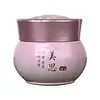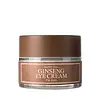What's inside
What's inside
 Key Ingredients
Key Ingredients

 Benefits
Benefits

 Concerns
Concerns

 Ingredients Side-by-side
Ingredients Side-by-side

Water
Skin ConditioningGlycerin
HumectantDipentaerythrityl Hexa C5-9 Acid Esters
Skin ConditioningButylene Glycol Dicaprylate/Dicaprate
EmollientCetyl Ethylhexanoate
EmollientCetearyl Alcohol
EmollientHydrogenated Vegetable Oil
EmollientPropanediol
SolventSqualane
EmollientNeopentyl Glycol Diheptanoate
EmollientPolyglyceryl-3 Methylglucose Distearate
EmulsifyingPanthenol
Skin ConditioningStearic Acid
CleansingPalmitic Acid
EmollientPinus Thunbergii Branch/Leaf Extract
Skin ProtectingEthyl Hexanediol
SolventTricholoma Matsutake Extract
Skin ConditioningPanax Ginseng Root Extract
EmollientPoria Cocos Extract
Skin ConditioningRehmannia Chinensis Root Extract
Skin ConditioningMacadamia Ternifolia Seed Oil
EmollientHoney Extract
HumectantButylene Glycol
HumectantBeta-Sitosterol
Emulsion StabilisingBrassica Campestris Sterols
EmollientPEG-5 Rapeseed Sterol
CleansingCholeth-24
EmulsifyingCeteth-24
CleansingHydrogenated Lecithin
EmulsifyingCeramide NP
Skin ConditioningPortulaca Oleracea Extract
Skin ConditioningAngelica Dahurica Root Extract
Skin ConditioningAdenophora Stricta Root Extract
HumectantCnidium Officinale Rhizome Extract
Skin ConditioningCoptis Japonica Extract
AntimicrobialForsythia Suspensa Fruit Extract
AntioxidantFritillaria Verticillata Bulb Extract
Skin ConditioningGlycyrrhiza Glabra Root Extract
BleachingGardenia Florida Fruit Extract
Skin ConditioningScutellaria Baicalensis Root Extract
AstringentSchizonepeta Tenuifolia Extract
Skin ConditioningMorus Alba Bark Extract
Skin ConditioningPapaver Rhoeas Petal Extract
EmollientTheobroma Cacao Extract
Skin ConditioningBeeswax
Emulsion StabilisingDextrin
AbsorbentCetyl Phosphate
EmulsifyingLecithin
EmollientGlyceryl Stearate
EmollientBehenyl Alcohol
EmollientPolyacrylate-13
Polyisobutene
Glyceryl Linoleate
EmollientTocopheryl Acetate
AntioxidantGlyceryl Polyacrylate
Polysorbate 20
EmulsifyingCaprylic/Capric Triglyceride
MaskingGlyceryl Arachidonate
EmollientAdenosine
Skin ConditioningSorbitan Isostearate
EmulsifyingAlcohol Denat.
AntimicrobialBHT
AntioxidantBenzophenone-5
UV AbsorberChlorphenesin
AntimicrobialDisodium EDTA
Phenoxyethanol
PreservativeCaprylyl Glycol
EmollientEthylhexylglycerin
Skin Conditioning1,2-Hexanediol
Skin ConditioningParfum
MaskingWater, Glycerin, Dipentaerythrityl Hexa C5-9 Acid Esters, Butylene Glycol Dicaprylate/Dicaprate, Cetyl Ethylhexanoate, Cetearyl Alcohol, Hydrogenated Vegetable Oil, Propanediol, Squalane, Neopentyl Glycol Diheptanoate, Polyglyceryl-3 Methylglucose Distearate, Panthenol, Stearic Acid, Palmitic Acid, Pinus Thunbergii Branch/Leaf Extract, Ethyl Hexanediol, Tricholoma Matsutake Extract, Panax Ginseng Root Extract, Poria Cocos Extract, Rehmannia Chinensis Root Extract, Macadamia Ternifolia Seed Oil, Honey Extract, Butylene Glycol, Beta-Sitosterol, Brassica Campestris Sterols, PEG-5 Rapeseed Sterol, Choleth-24, Ceteth-24, Hydrogenated Lecithin, Ceramide NP, Portulaca Oleracea Extract, Angelica Dahurica Root Extract, Adenophora Stricta Root Extract, Cnidium Officinale Rhizome Extract, Coptis Japonica Extract, Forsythia Suspensa Fruit Extract, Fritillaria Verticillata Bulb Extract, Glycyrrhiza Glabra Root Extract, Gardenia Florida Fruit Extract, Scutellaria Baicalensis Root Extract, Schizonepeta Tenuifolia Extract, Morus Alba Bark Extract, Papaver Rhoeas Petal Extract, Theobroma Cacao Extract, Beeswax, Dextrin, Cetyl Phosphate, Lecithin, Glyceryl Stearate, Behenyl Alcohol, Polyacrylate-13, Polyisobutene, Glyceryl Linoleate, Tocopheryl Acetate, Glyceryl Polyacrylate, Polysorbate 20, Caprylic/Capric Triglyceride, Glyceryl Arachidonate, Adenosine, Sorbitan Isostearate, Alcohol Denat., BHT, Benzophenone-5, Chlorphenesin, Disodium EDTA, Phenoxyethanol, Caprylyl Glycol, Ethylhexylglycerin, 1,2-Hexanediol, Parfum
Water
Skin ConditioningButylene Glycol
HumectantCaprylic/Capric Triglyceride
MaskingGlycerin
HumectantPanax Ginseng Root Extract
EmollientCetearyl Olivate
Simmondsia Chinensis Seed Oil
EmollientButyrospermum Parkii Butter
Skin ConditioningCetearyl Alcohol
EmollientSorbitan Olivate
EmulsifyingBeeswax
Emulsion StabilisingMethylpropanediol
SolventHydroxyethyl Acrylate/Sodium Acryloyldimethyl Taurate Copolymer
Emulsion StabilisingIsododecane
EmollientBetaine
HumectantHexanediol
SolventDimethicone
EmollientDimethicone/Vinyl Dimethicone Crosspolymer
Skin ConditioningGlyceryl Caprylate
EmollientSoluble Collagen
HumectantDipotassium Glycyrrhizate
HumectantAllantoin
Skin ConditioningAdenosine
Skin ConditioningDisodium EDTA
Pulsatilla Koreana Extract
Skin ConditioningZanthoxylum Piperitum Fruit Extract
Skin ConditioningEthylhexylglycerin
Skin ConditioningSorbitan Isostearate
EmulsifyingSqualane
EmollientSodium Acetylated Hyaluronate
HumectantHydrolyzed Hyaluronic Acid
HumectantBoswellia Serrata Resin Extract
SmoothingWater, Butylene Glycol, Caprylic/Capric Triglyceride, Glycerin, Panax Ginseng Root Extract, Cetearyl Olivate, Simmondsia Chinensis Seed Oil, Butyrospermum Parkii Butter, Cetearyl Alcohol, Sorbitan Olivate, Beeswax, Methylpropanediol, Hydroxyethyl Acrylate/Sodium Acryloyldimethyl Taurate Copolymer, Isododecane, Betaine, Hexanediol, Dimethicone, Dimethicone/Vinyl Dimethicone Crosspolymer, Glyceryl Caprylate, Soluble Collagen, Dipotassium Glycyrrhizate, Allantoin, Adenosine, Disodium EDTA, Pulsatilla Koreana Extract, Zanthoxylum Piperitum Fruit Extract, Ethylhexylglycerin, Sorbitan Isostearate, Squalane, Sodium Acetylated Hyaluronate, Hydrolyzed Hyaluronic Acid, Boswellia Serrata Resin Extract
 Reviews
Reviews

Ingredients Explained
These ingredients are found in both products.
Ingredients higher up in an ingredient list are typically present in a larger amount.
Adenosine is in every living organism. It is one of four components in nucleic acids that helps store our DNA.
Adenosine has many benefits when used. These benefits include hydrating the skin, smoothing skin, and reducing wrinkles. Once applied, adenosine increases collagen production. It also helps with improving firmness and tissue repair.
Studies have found adenosine may also help with wound healing.
In skincare products, Adenosine is usually derived from yeast.
Learn more about AdenosineBeeswax is natural wax produced by honey bees and can be synthetically created. It consists mainly of fatty acid esters and long-chain alcohols.
In cosmetics, beeswax is a emollient. Due to its waxy structure, it creates a protective barrier. This barrier prevents water from evaporating off the skin.
This may not be a good ingredient for oily skin. We recommend speaking with a professional if you have concerns.
Beeswax cannot be removed with water, but can be taken off with an oil cleanser.
Beeswax is also antiseptic and contains vitamin A.
Learn more about BeeswaxButylene Glycol (or BG) is used within cosmetic products for a few different reasons:
Overall, Butylene Glycol is a safe and well-rounded ingredient that works well with other ingredients.
Though this ingredient works well with most skin types, some people with sensitive skin may experience a reaction such as allergic rashes, closed comedones, or itchiness.
Learn more about Butylene GlycolThis ingredient is an emollient, solvent, and texture enhancer. It is considered a skin-softener by helping the skin prevent moisture loss.
It helps thicken a product's formula and makes it easier to spread by dissolving clumping compounds.
Caprylic Triglyceride is made by combining glycerin with coconut oil, forming a clear liquid.
While there is an assumption Caprylic Triglyceride can clog pores due to it being derived from coconut oil, there is no research supporting this.
Learn more about Caprylic/Capric TriglycerideCetearyl alcohol is a mixture of two fatty alcohols: cetyl alcohol and stearyl alcohol. It is mainly used as an emulsifier. Emulsifiers help prevent the separation of oils and products. Due to its composition, it can also be used to thicken a product or help create foam.
Cetearyl alcohol is an emollient. Emollients help soothe and hydrate the skin by trapping moisture.
Studies show Cetearyl alcohol is non-toxic and non-irritating. The FDA allows products labeled "alcohol-free" to have fatty alcohols.
This ingredient is usually derived from plant oils such as palm, vegetable, or coconut oils. There is debate on whether this ingredient will cause acne.
Due to the fatty acid base, this ingredient may not be Malassezia folliculitis safe.
Learn more about Cetearyl AlcoholDisodium EDTA plays a role in making products more stable by aiding other preservatives.
It is a chelating agent, meaning it neutralizes metal ions that may be found in a product.
Disodium EDTA is a salt of edetic acid and is found to be safe in cosmetic ingredients.
Learn more about Disodium EDTAEthylhexylglycerin (we can't pronounce this either) is commonly used as a preservative and skin softener. It is derived from glyceryl.
You might see Ethylhexylglycerin often paired with other preservatives such as phenoxyethanol. Ethylhexylglycerin has been found to increase the effectiveness of these other preservatives.
Glycerin is already naturally found in your skin. It helps moisturize and protect your skin.
A study from 2016 found glycerin to be more effective as a humectant than AHAs and hyaluronic acid.
As a humectant, it helps the skin stay hydrated by pulling moisture to your skin. The low molecular weight of glycerin allows it to pull moisture into the deeper layers of your skin.
Hydrated skin improves your skin barrier; Your skin barrier helps protect against irritants and bacteria.
Glycerin has also been found to have antimicrobial and antiviral properties. Due to these properties, glycerin is often used in wound and burn treatments.
In cosmetics, glycerin is usually derived from plants such as soybean or palm. However, it can also be sourced from animals, such as tallow or animal fat.
This ingredient is organic, colorless, odorless, and non-toxic.
Glycerin is the name for this ingredient in American English. British English uses Glycerol/Glycerine.
Learn more about GlycerinGinseng root is a well-loved ingredient in Asian skincare for good reason. It hydrates the skin, soothes irritation, and helps even out skin tone.
In traditional East Asian medicine, ginseng has been used for centuries both as food and as a healing remedy, and modern research continues to confirm its skin benefits.
One of the standout features of ginseng is its ability to improve blood circulation and oxygen delivery to the skin, bringing a fresh supply of nutrients to support overall skin health. It also has antioxidant and anti-inflammatory properties. This helps to protect your skin against damage from UV exposure, pollution, and daily stress.
Additionally, studies suggest that ginseng may help reduce hyperpigmentation by inhibiting tyrosinase, the enzyme involved in melanin production.
There are different types of ginseng used in skincare, and while they all share core benefits, their potency can vary.
Most products use fresh or white ginseng because it’s more affordable. However, red ginseng, produced by steaming the root, contains higher levels of ginsenosides, which are compounds with proven anti-aging effects. These ginsenosides help reduce the appearance of wrinkles and improve skin elasticity.
Note: All forms of ginseng are listed simply as “Panax ginseng” in ingredient lists. We recommend reaching out to the brand if you have questions about which type of ginseng is used in their ingredients.
For general antioxidant benefits, any ginseng extract will do, but for wrinkle care or firmer skin, red or fermented ginseng is often more effective.
In short, ginseng is a powerhouse ingredient that supports hydration, radiance, and resilience.
Learn more about Panax Ginseng Root ExtractSorbitan Isostearate is an emulsifer and cleaning agent. It is created from isostearic acid and sorbitol.
As an emulsifier, Sorbitan Isostearate prevents oils and water from separating.
Due to its isostearic acid base, it may not be safe for Malassezia or fungal acne.
Learn more about Sorbitan IsostearateSqualane is an emollient that helps the skin hold onto moisture. It's an oily liquid that occurs naturally in certain types of fish and plant oils.
Because squalane boosts hydration in the skin, it also comes with plenty of benefits: it is an antioxidant and can help fight free radicals and skin damage. Squalane is also found to have a detoxifying effect when applied.
Squalane comes from squalene, which occurs naturally within the sebum of our skin. It is one of the oils our skin produces to keep itself hydrated. Squalane is the hydrogenated version of squalene and has a longer shelf life.
Research shows that squalane is non-irritating (even at 100% concentration).
In general, it's a fantastic ingredient. It does a great job at hydrating the skin, and it's suitable for those with sensitive skin.
The source of squalane may impact malassezia / fungal acne. This is because olive oil derived squalane can contain impurities such as fatty acids and plant waxes. Sugarcane derived squalane is recommended for anyone with malassezia concerns.
Is squalane vegan?
This depends on the source. Squalane can be derived from both plants and animals. Most squalane used in skincare comes from plants.
Please note: the source of squalane is only known if disclosed by the brand. We recommend reaching out to the brand if you have any questions about their squalane.
Read more about squalene with an "e".
Is squalane an oil?
Squalane is often called an oil, but it’s technically not; it’s a hydrocarbon, meaning it’s only made of carbon and hydrogen, unlike true oils which are triglycerides made of fatty acids and glycerol.
The term “oil-free” isn’t regulated, so companies can define it however they want. Some exclude all oils, while others just avoid mineral oil or comedogenic oils.
While some people avoid oils thinking they cause breakouts, the right kind of oil (or oil-like ingredient like squalane) can actually help balance and hydrate your skin. It’s worth testing out simple oils or squalane to see what works best for your skin.
Learn more about SqualaneWater. It's the most common cosmetic ingredient of all. You'll usually see it at the top of ingredient lists, meaning that it makes up the largest part of the product.
So why is it so popular? Water most often acts as a solvent - this means that it helps dissolve other ingredients into the formulation.
You'll also recognize water as that liquid we all need to stay alive. If you see this, drink a glass of water. Stay hydrated!
Learn more about Water